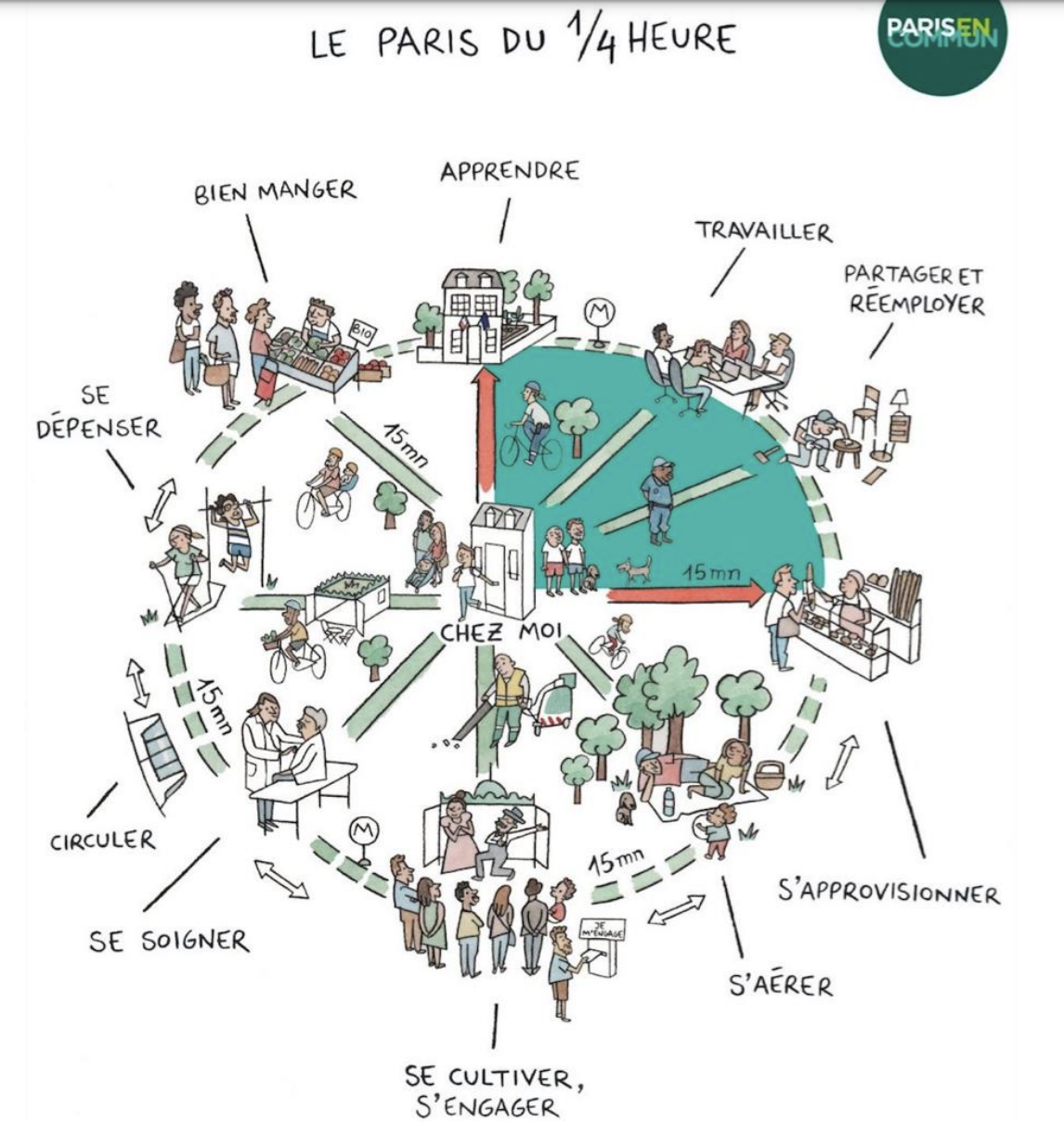Pedestrians / Walking
15-minute city: A network of 15-minute neighbourhoods
Brett Petzer in conversation with Carlos Moreno, Professor at Panthéon Sorbonne University and name behind the concept of the 15-minute city adopted in Paris, discussing its conception, it’s applications, and the role of the pedestrian in a 15-minute city. Original publication in Dutch for Verkeerskunde HERE.

 Q – You are a professor at the Sorbonne and are the author of multiple books, including Droit de cité (The Right to the City) and Urban life and proximity at the time of COVID19? (Amazon.fr e-book, €2 – available in FR, EN, ES, IT, PT) . Your work has also been embraced as a planning principle by the City of Paris, which is making exceptionally rapid progress in implementing this vision. How did this collaboration come about, and what interaction do you have with the city, or with plans or planning processes?
Q – You are a professor at the Sorbonne and are the author of multiple books, including Droit de cité (The Right to the City) and Urban life and proximity at the time of COVID19? (Amazon.fr e-book, €2 – available in FR, EN, ES, IT, PT) . Your work has also been embraced as a planning principle by the City of Paris, which is making exceptionally rapid progress in implementing this vision. How did this collaboration come about, and what interaction do you have with the city, or with plans or planning processes?
I was born in Colombia, but have lived in Paris, my adopted home, for 42 years. I have a deep connection to it, and have seen it change profoundly in this time. I have worked in many, many places around the world, but was especially eager to make a contribution here. My opportunity came through an existing collaboration between the City of Paris and the Sorbonne, where we started to discuss ideas like the ’15-minute city’ (ville du quart d’heure) and the ‘nearby city’ (ville de proximité). We started conducting living labs in certain arondissements (neighbourhoods) in the city. When [the current mayor] Anne Hidalgo was searching for a conceptual framework to structure her reelection campaign’s commitments on the environment, climate and mobility, these concepts appealed to her for their simplicity in combination with a somewhat radical vision. The timing was also important – 5 years after the Paris climate accords, the time was ripe for this level of ambition. The arrival of Covid-19 only emphasised the importance of the 15- minute city, as Parisians found themselves confined to a small radius around their homes during the confinement (lockdown).
Q – About the “15-minute city” – when one looks at the centre of cities like Paris, or Amsterdam, one sees a 15-minute city where the best infrastructure converges. It is a place of hyper-proximity. However, especially in the past two decades, these same places seem increasingly to house the hyper-mobile elite. Is this a paradox? Is there a certain ‘15-minute city’ that is created by the free market, and another that must be created around a social vision? How does one choose between these, and how does one get from one to the other? Put differently, is it true that a ‘15-minute city’ already exists for the rich, and if so, does this vision exclude lower-income urban residents?
This is a good question, and a good point of departure for diagnosing the mechanisms that have led us to this point. It is clear that our cities [in Europe] are places in which resources are distributed unequally, in which destinations and origins for everyday trips are often further from each other for those who are not elites, and that there are many man-made factors that induce artificially long journeys. Sometimes, we spend our lives earning a living [‘Nous perdons notre vie pour la gagner’]. And in the midst of all this induced mobility across the city, we quite often do not know our own neighbours, and we have little interaction with our immediate neighbourhood.
The 15-minute city is an agenda that demands more and better usage of the places in which we live. This requires investment, yes, but also creativity and flexibility. How many public facilities serve only a single function, for a few hours a week, when they could – with some vision and refurbishment – become multifunctional? How many neighbourhoods, which should support a lively ecosystem of local shops and services, have become 2/4 monocultures due to the unchecked spread of Airbnb, and other influences? The result of underutilised public infrastructure and a lack of balance in how resources like housing are allocated has, indeed, produced a scarcity of neighbourhoods in which a person can meet their needs within about a 15-minute walk. And yes, the result can be that elites outbid everyone else to live in these places, producing gentrification.
For this reason, the 15-minute city depends on a strong and clear social vision, starting with an audit of all the city’s facilities, resources and infrastructures. Their distribution needs to be rationalised to create an overlapping mesh of high-quality basic services that reach everyone, so that people are only obliged to travel longer distances if they want to reach more specialised services.
This may require some new construction, but mostly this vision of urbanism depends on reuse, reallocation and renovation of existing infrastructure, as well as urban space. For example, the vast quantity of urban space now dedicated to on-street is obviously a priority for reallocation to pocket parks, social streets, and dignified squares.
Larger indoor spaces could function around the clock for afternoon sports clubs, evening language lessons, and late-night social events. Private spaces also have a role to play here. This all needs to be brought about by small-scale local authorities with a high degree of public participation, and that participation needs to be incentivised by giving local residents a real stake in their urban commons, with the money and power to make the most of them.
Q – How would you describe this process and paradox with reference to Paris?
In Paris, we already have some of the tools needed to realise this shift. The city is active in buying up and leasing out strategically located properties, to support community vitality. We have our social housing systems. By building on this basis we can achieve a ‘big bang’ in hyperlocal urbanism in Paris. This will require a major reform of city government, which is part of the Mayor’s vision, to delegate these powers down to the local level.
Q – What is the role of pedestrians in this vision? What priority do they have?
To start with, the pedestrian is the measure of the ’15 minutes’ we are talking about here. Of course, everyone’s fifteen minute walk will differ. Hence the importance of the overlapping mesh that creates a polycentric city, in which the 15-minute walking radius is a rough physical analogue for what I call a ‘chronotopia’ [chronotopie] or time-scape. By this I simply mean the creation of an urban fabric in which residents grow accustomed to the idea that a full local life is possible. They should be able to eat well; receive an education or training; go to work; share and reuse skills and goods; buy household essentials and groceries; get some fresh air; access culture and engage in their community; access medical care, and exercise, all within about a quarter of an hour’s walk from home. The role of public transport in this vision is as a peripheral connector for all these fifteen-minute destinations. The sum total of this vision, however, is more than just a shift in mobility. Instead, it is nothing less than a re-anchoring of urban life into meaningful local connections and urban villages that can offer a real and rooted alternative to hyper-consumption, hyper-mobility and an always-online existence.
Q – Why should our readers read your book on this subject? And what message do you have for Dutch readers?
I look forward to engaging with Dutch readers who may wish to read my English-language e-book. And it must be acknowledged that Dutch cities are already leaders in developing fifteen-minute cities. I hope to see the professional readership of Verkeerskunde add their perspective and influence to our common agenda, including through networks such as the C40 cities [of which Amsterdam and Rotterdam are members]. The high quality of the urban planning that one can find all over Dutch cities – small, unique, memorable public spaces, parks with public art, water everywhere – is a powerful example of how urban life can offer experiences that technology cannot replace. These experiences are a precious raw material for creating more connected urban communities at a human (time)scale.
 ">
">Brett Petzer
‘The hard work and the resources dedicated to making claims for space in a city are a reflection of their true priorities. I want these claims to become more equitable, so that motorists must work as hard to retain parking space as cyclists and pedestrians have to work to gain safe space.’

